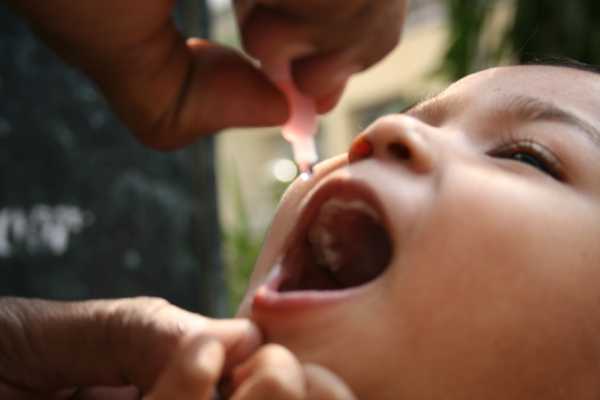
The global push to immunize children against polio has been an incredible success, reducing polio cases by 99.9 percent.
But there’s a lingering obstacle to a polio-free world: A scant number of people who got one version of the vaccine before it was phased out in 2016 carry a variant of the polio virus that was in that vaccine and has since mutated. The mutated virus can now be passed around in areas where few people have been vaccinated, sickening some along the way.
This is precisely what’s playing out right now, in a very small polio outbreak in the Democratic Republic of the Congo, and with a handful of cases in a few other countries.
This year, DRC has registered no wild polio viruses — that is, polio cases caught from the environment. And Type 2 polio has been completely eradicated in the wild since 1999. But DRC has seen seven cases of Type 2 polio this year that are linked to the vaccine in an outbreak.
The outbreak of vaccine-derived polio was first registered last June, in Maniema province, the central-eastern part of DRC. It has since spread to the south, and popped up in two provinces in the north.
“It’s worrying because it’s spreading,” said Michel Zaffran, director of the polio eradication program at the World Health Organization, who added that the government is not yet taking the outbreak seriously enough. There are, thankfully, stockpiles of the polio-2 vaccine at the ready to confront resurgent outbreaks.
The success of the global polio eradication campaign may hinge on the outcome of the DRC’s polio outbreak. Experts like Zaffran say beating the vaccine-derived version of the horrible paralysis-inducing disease is just as important as stopping wild polio from spreading. Here’s why.
Why the oral polio vaccine has become a threat to polio eradication
The World Health Organization’s polio eradication program, which began in 1988, has been one of the greatest success stories in global health. At its peak in the middle of the 20th century, polio killed half a million people every year. In 1988, there were more than 125 polio-endemic countries. Now there are only three: Nigeria, Pakistan and Afghanistan (where ongoing political conflicts have made eradication efforts difficult).
This success can be traced back to 1950s, when Albert Sabin noticed that not all strains of polio virus-infected monkeys when exposed. He was able to isolate these strains — and prove they wouldn’t infect humans — and form them into a swallowable serum that could be easily distributed the world over. (Jonas Salk, you may recall, invented the first polio vaccine, which was an injectable.)
That oral polio vaccine (or OPV, as it’s often called) became the favored vaccine of the World Health Organization in its eradication efforts. It’s extremely effective at immunizing the gut, where polio takes root in the body. Some 3 billion children have received this vaccine in the past 10 years alone.
Make no mistake: The world is this close to eradicating the disease because of the oral vaccine.
But the oral vaccine also came with a small risk: It can cause new cases of the disease.
“Very quickly, after you take the vaccine, [oral-vaccine viruses] revert” to a dangerous form, Vincent Racaniello, a Columbia professor of microbiology and immunology, said in a 2016 interview. This typically isn’t a problem, since by the time they become virulent, a person — and his or her surrounding community — is immune.
But if immunization is spotty, and if sanitation is lacking (as the virus is often passed through the gut into sewer systems), vaccine-derived polio can continue to spread for years.
Transmission of vaccine-derived polio works like this: A person swallows the oral vaccine, which contains a live, weakened virus. That virus can live in the gut for a while, and then pass from person-to-person, developing mutations along the way. “When it circulates for a long time among too many poorly vaccinated or unvaccinated children,” said Zaffran, “this is how it is allowed to mutate and become virulent again.”
The gap between wild polio cases and vaccine-derived cases is narrowing
That’s what’s happening in the DRC, where people are getting sick with a vaccine-derived variant of polio virus type-2.
In 2016, the Polio Global Eradication Initiative phased out the use of the polio type-2 oral vaccine. “The outbreaks we are seeing now were seeded by vaccines used before switch in April 2016,” Zaffran said. “The same vaccine has been used in 155 countries for many years and the [vaccine-derived polio cases] have occurred only in a small number of countries with chronically low immunization coverage or with marginalized groups of population who do not have access to the immunization system,” he added — like DRC.
The Eradication Initiative would like to (ideally) phase out all oral vaccines by 2020, and replace them with injectable vaccine. The injectable vaccines contain a dead virus that cannot cause polio, but they are more expensive and harder to administer.
According to the WHO’s latest count, there have been seven vaccine-derived polio cases in the DRC this year, as well as one case in Nigeria, three in Somalia, and one in Papua New Guinea. Compare that to the numbers of wild polio virus cases: Afghanistan has seen eight this year, and Pakistan, three.
In 2017, there were 96 cases — globally — of vaccine-derived polio and just 22 cases from the wild virus. “I would not say vaccine-derived polio viruses are more of an issue than wild polio viruses, but they are paralyzing kids more often and we need to treat them with same seriousness and speed [as wild polio],” Zaffran said. “If DRC doesn’t manage to get its outbreak under control, we are running the risk of having exportation of this outbreak into neighboring countries.”
Recently, the DRC’s health ministry — with the help of international partners like the WHO — managed to organize the world’s first Ebola vaccination campaign early on in an outbreak and rapidly interrupt the spread of the deadly virus, which had already reached urban centers. That’s a sign they can do the same for vaccine-derived polio, Zaffran said. The outbreak just needs to attract enough attention and political will.
Sourse: vox.com






